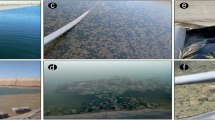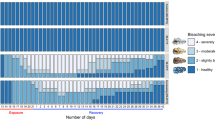Abstract
The disappearance of submerged vascular macrophytes in shallow eutrophic lakes is a common phenomenon in the world. To explore the mechanism of the decline in submerged macrophyte abundance due to the growth of epiphytic algae along a nutrient gradient in eutrophic water, a 2 × 3 factorial experiment was performed over 4 weeks with the submerged macrophyte (Myriophyllum spicatum L.) by determining the plant’s biomass and some physiological indexes, such as chlorophyll (Chl) content, malondialdehyde (MDA) content, and superoxide dismutase (SOD) activity in the leaves of M. spicatum L. on days 7, 14, 21, and 28, which are based on three groups of nitrogen and phosphorus levels in the water body (N-P [mg L−1]: NP1 0.5–0.05, NP2 2.5–0.25, NP3 4.5–0.45) and two levels of epiphytic algae (the epiphytic algae group and the control group). Epiphytic algal biomass was also assayed. The results indicated that epiphytic algal biomass remarkably enhanced in the course of the experiment with elevated levels of nitrogen and phosphorus in the water. Under the same level of nutrient condition, plants’ biomass accumulation and Chl content were higher in the control group than that in the epiphytic algae group, respectively, while MDA content and SOD activity in the former were lower than that in the latter. The influences of epiphytic algae on the biomass accumulation and Chl content and MDA content became greater and greater with elevated levels of nutrients. In general, in this experiment, water nutrients promoted the growth of both epiphytic algae and submerged plants, while the growth of epiphytic algae hindered submerged macrophytes’ growth by reducing Chl content and promoting peroxidation of membrane lipids in plants.





Similar content being viewed by others
References
Asaeda T, Sultana M, Manatunge J, Fujino T (2004) The effect of epiphytic algae on the growth and production of Potamogeton perfoliatus L. in two light conditions. Environ Exp Bot 52:225–238
Balls H, Moss B, Irvine K (1989) The loss of submerged plants with eutrophication I. Experimental design, water chemistry, aquatic plant and phytoplankton biomass in experiments carried out in ponds in the Norfolk Broadland. Freshw Biol 22:71–87
Beauchamp C, Fridovich I (1971) Superoxide dismutase: improved assays and an assay applicable to acrylamide gels. Anal Biochem 44:276–287
Cai XL, Gao G, Tang XM, Dai JY, Chen D (2012) Photosynthetic response of Vallisneria natans, (Lour.) Hara (Hydrocharitaceae) to increasing nutrient loadings. Photosynthetica 50:437–446
Chen C, Yin DQ, Yu B, Zhu HK (2007) Effect of epiphytic algae on photosynthetic function of Potamogeton crispus. J Freshw Ecol 22:411–420
Fong CW, Lee SY, Wu RSS (2000) The effects of epiphytic algae and their grazers on the intertidal seagrass Zostera japonica. Aquat Bot 67:251–261
Gulati RD, Pires LMD, Donk EV (2008) Lake restoration studies: failures, bottlenecks and prospects of new ecotechnological measures. Limnologica 38:233–247
He H, Liu XB, Liu XL, Yu JL, Li KY, Guan BH, Jeppesen E, Liu ZW (2014) Effects of cyanobacterial blooms on submerged macrophytes alleviated by the native Chinese bivalve Hyriopsis cumingii: a mesocosm experiment study. Ecol Eng 71:363–367
Heck KL Jr, Valentine JF, Pennock JR, Chaplin G, Spitze PM (2006) Effects of nutrient enrichment and grazing on shoalgrass Halodule wrightii and its epiphytes: results of a field experiment. Mar Ecol Prog 326:145–156
Hilt S, Gross EM (2008) Can allelopathically active submerged macrophytes stabilise clear-water states in shallow eutrophic lakes? Basic Appl Ecol 9:422–432
Hu HJ, Wei Y (2006) The freshwater algae of China: systematics, taxonomy and ecology. Science Press, Beijing
Jackson LJ (2003) Macrophyte-dominated and turbid states of shallow lakes: evidence from Alberta lakes. Ecosystems 6:213–223
Jampeetong A, Brix H (2009) Effects of NH4+, concentration on growth, morphology and NH4 +,uptake kinetics of Salvinia natans. Ecol Eng 35:695–702
Janssen ABG, Teurlincx S, An S, Jansea JH, Paerl HW, Mooij WM (2014) Alternative stable states in large shallow lakes? J Great Lakes Res 40:813–826
Kamara S, Pflugmacher S (2007) Acclimation of Ceratophyllum demersum to stress imposed by Phragmites australis and Quercus robur leaf extracts. Ecotoxicol Environ Safety 68:335–342
Lauridsen TL, Jensen JP, Jeppesen E, Søndergaard M (2003) Response of submerged macrophytes in danish lakes to nutrient loading reductions and biomanipulation. Hydrobiologia 506–509:641–649
Li HS, Sun Q (2000) The experiment principle and technology of plantphysiology. Higher Education Press, Beijing
Loftus MC, Carpenter JH (1971) A fluoremetric method for determining chlorophylls a, b and c. JMar Res 29:319–338
Misra N, Gupta AK (2006) Effect of salinity and different nitrogen sources on the activity of antioxidant enzymes and indole alkaloid content in Catharanthus roseus seedlings. J Plant Physiol 163:11–18
Panda SK, Khan MH (2004) Changes in growth and superoxide dismutase activity in Hydrilla verticillata L. under abiotic stress. Braz J Plant Physiol 16:115–118
Phillips GL, Eminson D, Moss B (1978) A mechanism to account for macrophyte decline in progressively eutrophicated freshwaters. Aquat Bot 4:103–126
Qin BQ, Gao G, Zhu GW, Zhang YL, Song YZ, Tang XM, Xu H, Deng JM (2013) Lake eutrophication and its ecosystem response. ChinSci Bull 58:961–970
Roberts E, Kroker J, Körner S, Nicklisch A (2003) The role of periphyton during the re-colonization of a shallow lake with submerged macrophytes. Hydrobiologia 506–509:525–530
Romo S, Villena MMA (2007) Epiphyton, phytoplankton and macrophyte ecology in a shallow lake under in situ experimental conditions. Funda Appl Limnol 170:197–209
Sand-Jensen K, Søndergaard M (1981) Phytoplankton and epiphyte development and their shading effect on submerged macrophytes in lakes of different nutrient status. Internationale Revue Der Gesamten Hydrobiologie Und Hydrographie 66:529–552
Sand-Jensen K, Riis T, Vestergaard O, Larsen SE (2000) Macrophyte decline in Danish lakes and streams over the past 100 years. J Ecol 88:1030–1040
Scheffer M (1998) Ecology of shallow lakes. Chapman and Hall, London
Song YZ, Wang JQ, Gao YX, Xue XJ (2015) The physiological responses of Vallisneria natans to epiphytic algae with the increase of nitrogen and phosphorus concentrations in water bodies. Environ Sci Pollut Res 22:8480–8487
Sudhakar C, Reddy PS, Veeranjaneyulu K (2009) Changes in respiration, its allied enzymes, pigment composition, chlorophylase and hill reaction activity of horsegram seedlings under salt. Neurocomputing 72:2636–2642
The State Environmental Protection Administration (2002) Water and wastewater monitoring and analysis method, 4th edn. China Environmental Science Press, Beijing
Tóth VR (2013) The effect of periphyton on the light environment and production of Potamogeton perfoliatus, L. in the mesotrophic basin of Lake Balaton. Aquat Sci 75:523–534
Xing W, Wu HP, Hao BB, Liu GH (2013) Stoichiometric characteristics and responses of submerged macrophytes to eutrophication in lakes along the middle and lower reaches of the Yangtze River. Ecol Eng 54:16–21
Zhang M, Cao T, Ni L, Xie P, Li Z (2010) Carbon, nitrogen and antioxidant enzyme responses of Potamogeton crispus, to both low light and high nutrient stresses. Environ Exp Bot 68:44–50
Acknowledgements
The authors greatly acknowledge G. Gao for his language editing. We also thank B. Qin for his help and encouragement. This work was funded by the National Natural Science Foundation of China (NSFC) (No. 41471446)
Author information
Authors and Affiliations
Corresponding author
Additional information
Responsible editor: Philippe Garrigues
Rights and permissions
About this article
Cite this article
Song, YZ., Wang, JQ. & Gao, YX. Effects of epiphytic algae on biomass and physiology of Myriophyllum spicatum L. with the increase of nitrogen and phosphorus availability in the water body. Environ Sci Pollut Res 24, 9548–9555 (2017). https://doi.org/10.1007/s11356-017-8604-6
Received:
Accepted:
Published:
Issue Date:
DOI: https://doi.org/10.1007/s11356-017-8604-6




